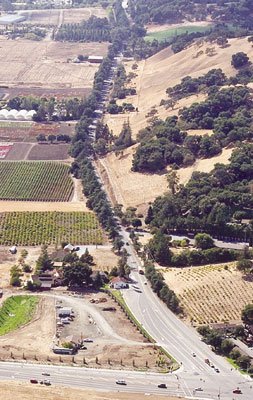Gilroy
– A row of majestic west Gilroy cedar trees that inspired a
clash between developers and environmentalists may soon be added to
a federal list of historic places.
Gilroy – A row of majestic west Gilroy cedar trees that inspired a clash between developers and environmentalists may soon be added to a federal list of historic places.
The historical value of 115 Deodar cedars and 20 oak cedars along Hecker Pass Highway will be reviewed Thursday by the California State Historical Resources Commission, which recommends or denies sites for inclusion on the National Register of Historic Places.
The trees lining the 1.39 mile stretch, between Santa Teresa Boulevard and Uvas Creek, were planted on National Arbor Days in 1930 and 1931.
Two dozen of the trees were saved last year following months of debate on plans to widen the scenic highway to accommodate hundreds of new homes. Four trees remain on the chopping block to make way for a future intersection facing Gilroy Golf Course.
A listing on the National Register does not prevent demolition. Rather, it triggers an extra layer of review on development projects to determine their impact on the trees as an historical resource. In some cases, a regulatory review can lead to alternative project designs or “mitigations” such as planting new trees.
“The intent of the National Register was to be a program of honor and recognition with the idea that it would be used as a planning tool,” said Cynthia Howse, a state historian with the California Department of Parks and Recreation. “Oftentimes, a listing on the register does change the way people do things. They say, ‘This is worth preserving. It’s a part of our history.’ It can be a strong psychological tool.”
Howse predicted likely approval of the area as a historical resource based on a recommendation for approval by commission staff.
The area was nominated for inclusion on the list by the Gilroy Historical Society. Connie Rogers, president of the historical society, said the state Department of Transportation unearthed much of the history of the trees in the course of a review on a project to relocate the Hecker Pass bridge spanning Uvas Creek.
The agency learned that local Boy Scouts, Camp Fire Girls, members of the American Legion Auxiliary and Rotary Club, and others planted the first of the cedars March 7, 1930. On that Arbor Day, roughly 25,000 trees were planted across California, the state’s contribution to a nationwide movement to beautify highways as driving emerged as an American pastime.
“What we’re trying to do to is bring a little more awareness of a local resource,” said Rogers. “(The cedars) make Gilroy unique and contribute aesthetically. We’re one of the only cities that have a tree row left. Hecker Pass is a gateway to our city and it’s part of our tourism area, so in that sense they certainly … are part of what makes Gilroy an attractive place to visit.”
A fierce debate over the trees erupted last year when the members of the Gilroy Historical Socity, Save Open Space Gilroy and other preservation advocates learned that development plans for Hecker Pass threatened 28 Deodar Cedars. Plans for more than 400 homes were approved by council in 2005, and called for a road widening and two intersections with signals on Hecker Pass to accommodate new residents, most of them slated to live on the south side of the road.
The Hecker Pass Specific Plan, approved in 2005, did not suggest the need to remove the cedars. The consequence of development emerged last year as landowners pushed forward on more detailed engineering studies for the area.
The ensuing outcry from environmentalists and residents inspired council to come up with a solution that pleased all sides: Eliminate one of the two intersections and avoid cutting down all but four or five trees. (Developers eliminated plans for an intersection at the driveway of Lutheran Church of the Good Shepherd, just west of Santa Teresa Boulevard; they will only construct an intersection to the west near Gilroy public golf course).
“There was an effort to minimize the number of trees that would be removed as part of any widening,” said Chris Vanni, who owns 32 acres in the 423-acre area governed by the Hecker Pass Specific Plan.
During debate on the fate of the trees, Vanni and other landowners pointed to a city arborist report claiming the cedars were no longer healthy. Environmentalists commissioned their own study that said the majority of trees were healthy.
Age and historical significance are often subjective, Vanni said, “but it is a good looking tree row. There’s no arguing that.”
If the state’s Historical Resources Commission approves the Hecker Pass trees for inclusion on the National Register, their recommendation will be forwarded to federal officials at the latter agency in Washington for a final decision. Howse said that review typically takes 45 days.
The city has already signed off on construction of more than 100 homes in the Hecker Pass area, though Vanni said plans are delayed at the moment as landowners wait for the housing market to pick up.















